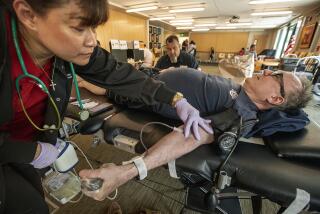PERSPECTIVE ON AIDS : How Human Behavior Woke the Viral Scourge : It is not a moral judgment to find that the gay sexual revolution had much to do with making an epidemic.
- Share via
If HIV and AIDS are indeed old killers, then one final, explosive question remains: Why did a virus that was confined to a tiny ecological niche suddenly burst into global pandemic?
In her forthcoming book, “The Coming Plague,” Newsday reporter Laurie Garrett outlines a crucial phase needed to transform a low level of virus into the outright epidemic phase she calls “amplification.” Some thing or things have to happen to force a microbe out of its previously placid ecological hole and stir it up to critical mass. The history of epidemics shows that such things are almost always related to human behaviors.
As might be expected, given the ways of the world, we know much more about the precise mechanisms that amplified AIDS in America than we do about Africa, but we know that in both continents enormous social and sexual revolutions closely predated the AIDS epidemic.
Northern AIDS (in the United States, Europe, Australia and Japan), say researchers, is primarily spread by anal sex and IV drug use; southern AIDS (in Africa, Central and South America and Asia) mostly by vaginal sex and improper medical sterilization of syringes. Northern AIDS overwhelmingly affects men, notably homosexual and bisexual men, and there is comparatively little female-to-male transmission. Southern AIDS strikes heterosexual men and women evenly, and women appear to transmit HIV to men as easily as men to women.
African historians say that decolonization there was followed by social shocks so profound that many cultures experienced greater change in a single generation than in the previous 1,000 years. Male African villagers, suddenly working in cities far from wives and family, replaced village monogamy or polygamy with multipartner urban sexuality. Women in the bustling cities were often compelled to engage in prostitution. There was a post-colonial explosion of unsterile needle use by ill-trained “needle doctors” and by poorly executed mass-immunization programs. Military conflicts were marked by epidemics of mass rape.
In America, the golden opportunities for AIDS--the blood products revolution, the IV drug revolution and the gay revolution--are obvious to anyone monitoring the epidemic. Tellingly, all those revolutions were launched at around the same time, the era of Woodstock and Stonewall.
Culling blood products from multiple donors began only in the 1960s, and the manufacture of clotting factors--developed from the blood of thousands of donors--began only in 1970. As a source of disease amplification, the blood revolution has built-in limitations. While it is medically easy for blood recipients to receive infectious agents, it is socially difficult for them to pass diseases on. Many blood recipients are elderly or chronically ill and do not donate blood or engage in IV drug use or sexual activity that might spread their infections. The main exceptions are hemophiliacs, but there are relatively few of them.
More than one-third of U.S. AIDS cases--about 113,000--are associated with IV drug use, while more than 80% of HIV-positive women inject drugs or have sexual partners who do. For the most part, however, users share needles with the same small cluster of people, keeping infection within a relatively restricted community, while poverty, lack of social mobility and a high death rate among IV users may impede HIV’s spread to the general population.
If the blood and IV drug revolutions created new viral highways that were medically efficient but socially limited, the sexual revolution among gay men in the 1970s created near-perfect conditions for viral amplification.
Gay men, according to Alfred Kinsey’s famous 1948 study of the sexual habits of American males, had relatively few sexual partners before liberation. As social conditions and sexual opportunities improved for gay men in the 1960s, health conditions in the ‘70s declined to the point where, by 1985, certain pockets of Manhattan’s growing gay community had incidences of genital herpes and other sexually transmitted diseases up to 20 times higher than heterosexual men of the same age. As the late AIDS activist Michael Callen noted, the gay male community was “wallowing . . . in an increasingly polluted microbiological sewer.”
The vortex of desire and disease facilitated the amplification of HIV in several interrelated ways. For starters, multi-partner sexual activity was raised to unprecedented levels, guaranteeing that any sexually transmitted microbe entering the gay reservoir would quickly spread to thousands and tens of thousands. Another was the practice of anal sex. While all forms of unprotected sex carry some risk of HIV transmission, studies show that for the receptive partner, unprotected anal sex is extremely risky.
Finally there’s the virulence factor. According to a theory advanced by Amherst’s Paul Ewald, author of “Evolution of Infectious Disease,” increased transmission may have literally amplified the virulence of HIV, which means two things: how easily a virus is spread and how fast it makes you sick.
According to natural selection, only those viral strains best suited to their environment will survive and reproduce. In a world when people had relatively few sex partners, the only strains of HIV likely to survive over the long haul were those that delayed making their hosts sick for decades and gave relatively monogamous hosts a chance to have sexual relations with several partners. But when HIV entered gay communities in which multipartner sex was the norm, this selective favoring of the least-virulent strains came to an end. Now, even though virulent strains made their hosts sicken faster, the time periods involved --several years instead of several decades--still gave those hosts ample time to infect many others. The result was a genetic favoring of the most virulent strains. Today, despite those who would have us believe that the pandemic is still confined to certain groups, infection has advanced to the point where everyone who engages in blood-sharing or unprotected sex outside a long-term monogamous relationship is at risk.






